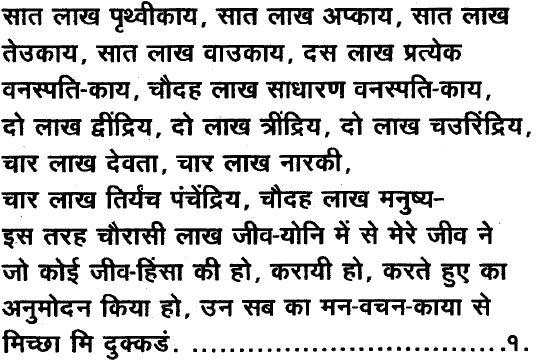Sāt Lākh Sutra
This sutra seeks forgiveness to all living beings (8.4 million jiva “yoni (योनि)” → life forms based on birth location).
Some consider it to be 8.4 million species of living beings, but this is not a correct interpretation of yoni. Yoni encapsulates all factors conducive for living being to take birth in any part of the universe. The 9 main factors are:
- Sacitta (सचित्त, “living matter)
- Acitta (अचित्त, “non living beings”)
- Sacittacitta (mixture of living being and animate matter)
- Śīta (शीत) – cold
- Uṣṇa (उष्ण) – hot
- Sitousna – hot and cold
- Saṃvṛta (संवृत) – covered
- Vivṛta (विवृत) – uncovered / exposed
- Saṃvṛta-Vivṛta: covered / uncovered
Living beings can be born in innumerable locations, however those that have similar touch, taste, colour and smell is considered as a yoni. Thus, the sum total of all yoni’s in Jain philosophy is 8.4 million which is where living beings take birth.
Living beings can be classified in various way according to Jain philosophy as follows:
- 1 → all livings beings have consciousness
- 2 → Mobile (tras) or Immobile (Sthavar)
- 3 → Based on gender: Male (पुल्लिंग), Female (स्त्रीलिङ्ग) & Neuter (नपुंसकलिङ्ग)
- 4 → Heavenly beings, Humans, Animals/Plants, Hellish beings
- 5 → 1 sensed, 2 sensed, 3 sensed, 4 sensed, 5 sensed living beings
- 6 → Earth bodied, water bodied, air bodied, fire bodied, plants & mobile living beings
Categories of various living beings is multiplied by the following to come up with the aggregate total:
- 5 types of colours (white (śukla), black (kṛṣṇa), blue (nīla), yellow (pīta) and red (lohita))
- 2 types of odour (fragrant (surabhi) and stench (asurabhi))
- 5 types of taste (bitter (tikta), sour (amla), astringent (kaṣāya), sweet (madhura) and pungent (kaṭu))
- 8 types of touch (soft (mṛdu), hard (kaṭhina), heavy (guru), light (laghu), cold (śīta), hot (uṣṇa), smooth (snigdha) and rough (rukṣa)
- 5 types of shapes (triangle, square, rectangle, round and oval)
This gives a multiple of 2000 (5 x 2 x 5 x 8 x 5) which is multiplied by the various categories of living beings. For instance:
350 types of earth bodied living beings x 2000 = 700,000 common factors for earth bodied living beings places of birth


Sāt lākha pṛthvikāya
700,000 yoni (location with common factors supporting life) of earth bodied living beings
Sāt lākha apkāya
700,000 yoni (location with common factors supporting life) of water bodied living beings
Sāt lākha teukāya
700,000 yoni (location with common factors supporting life) of fire bodied living beings
Sāt lākha vāukāya
700,000 yoni (location with common factors supporting life) of air bodied living beings
Dasa lākha pratyeka vanaspati kāya
1,000,000 yoni (location with common factors supporting life) of single bodied plant bodied living beings
Caudaha lākha sādhārana vanaspati kāya
1,400,000 yoni (location with common factors supporting life) of multiple souls in a single bodied plant living beings
Do lākha dvi indriya (in Gujarati Be lākha be-indriya)
200,000 yoni (location with common factors supporting life) of 2 sensed living beings
Do lākha trindriya (in Gujarati Be lākha te-indriya)
200,000 yoni (location with common factors supporting life) of 3 sensed living beings
Do lākha caurindriya (in Gujarati Be lākha caurindriya)
200,000 yoni (location with common factors supporting life) of 4 sensed living beings
Cāra lākha devatā
400,000 yoni (location with common factors supporting life) of heavenly beings
Cāra lākha nāraki
400,000 yoni (location with common factors supporting life) of hellish beings
Cāra lākha tiryanca panchendriya
400,000 yoni (location with common factors supporting life) of 5 sensed animals
Caudaha lākha manusya isa taraja (in Gujarati Caudaha lākha manusya evamkāre)
1,400,000 yoni (location with common factors supporting life) of human beings
Caurāsi lākha jiva yoni me se (in Gujarati Caurāsi lākha jiva yoni mahe)
Out of 8.4 million Jiva Yonis
Mere jiva ne (in Gujarati Mahāre jive)
My soul (consciousness)
Jo koi (in Gujarati Je koi)
Whichever
Jiva hinsā ki (in Gujarati Jiva Hanyo hoi)
Committed any violence
Karāyi ho (in Gujarati Hanāvyo hoi)
Having caused others to do violence
Karate hue kā anumodana kiya ho (in Gujarati Hantā pratye anumodhyo hoi)
Having appreciated others committing violence
Un saba kā (in Gujarati Te savi hu)
To all those
Mana vacana kāyā se micchāmi dukkadam (in Gujarati Mana vacana kāyāe kari micchāmi dukkadam)
May my misdeeds become fruitless as I seek forgiveness by mind, speech and body
Click here to download the Sat Lakh word to word English transaltion
References:
1. Prabodh Tika by Param Pujya Panyas BhadrankarVijayji Maharaj & Param Pujya Munishree Kalyanprabhavijayji Maharaj
2. Pratikramana Sutra With Explanation (Part 2) by Muni Nirvana Sagar
3. Internet
I apologise and seek pardon for any unintentional errors in translation of the verses.